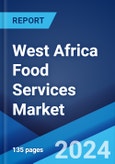The Increasingly Hectic Work Schedules of The Masses are Augmenting the Market Growth
The food services market has been experiencing continuous growth. The increasingly hectic lifestyles and work schedules of the masses represent one of the primary drivers resulting in the increasing adoption of food services. The growing work hours resulting in less time to time to prepare meals at home is resulting in a higher probability of individuals opting to eat out or order food for delivery. In addition to this, the shifting lifestyle patterns of West Africans due to the region's rapid urbanization and modernization is further fueling the demand for food services.The Considerable Growth in the Travel and Tourism Sector is Stimulating the Market Growth
West Africa is a culturally diverse region and is, therefore, a popular tourist destination, which is resulting in an increasing number of tourists supporting local eateries. The rising inclination of tourists towards local cuisines is leading to a considerable increase in demand for food services. Additionally, this growth in tourism has contributed to the development of the hospitality industry, which encompasses hotels, resorts, and lodges that offer local, multicuisine and gourmet dining options to cater to the demands of their guests. As a result, the food service industry in West Africa is facing a positive market outlook, with the establishment of new restaurants and food delivery services to address the increasing demand.Competitive analysis such as market structure, market share by key players, player positioning, top winning strategies, competitive dashboard, and company evaluation quadrant has been covered in the report. Also, detailed profiles of all major companies have been provided. The market structure is fragmented due to the presence of a large number of global and regional players. The volume of new entrants is moderate in the food services industry due to low product differentiation and switching cost, the requirement of high capital investment and R&D cost.
- What are Food Services?
West Africa Food Services Market Trends:
The market in West Africa is primarily driven by the inflating disposable income levels of the consumers, resulting in a shifting preference towards upscale and diverse dining experiences. In line with this, the rising popularity of global cuisines among individuals, particularly the younger population, is providing an impetus to the market. Moreover, a considerable rise in investments in the restaurant and hospitality sector by public as well as private agencies is creating lucrative growth opportunities in the market. In addition to this, the implementation of favorable initiatives by the governments of the West African countries, including tax incentives and subsidies for the promotion of local cuisine is also creating a positive market outlook. Furthermore, continual technological advancements, such as mobile ordering, contactless payment, and real-time delivery tracking is also acting as a significant growth-inducing factor for the market. Some of the other factors contributing to the market include rising demand for eateries specializing in healthier food options, the emerging trend of veganism resulting in the advent of vegan food service outlets, fierce competition among the key players, and extensive research and development (R&D) activities.Key Market Segmentation:
The publisher provides an analysis of the key trends in each sub-segment of the West Africa food services market report, along with forecasts at the regional and country level from 2024-2032. The report has categorized the market based on distribution channel, end-use, retail type and food service type.Distribution Channel Insights:
- Online
- Offline
End Use Insights:
- Commercial
- Non-Commercial
Retail Type Insights:
- Eat-In
- Take Away
Food Service Type Insights:
- Full Service Restaurants
- Fast-Food Joints
- Streets Kiosks/Stalls
- Cafes and Bars
- Others
Regional Insights:
- Nigeria
- Ghana
- Cote de Ivorie
- Cameroon
- Senegal
- Others
Competitive Landscape:
The report has also provided a comprehensive analysis of the competitive landscape in the West Africa food services market.Key Questions Answered in This Report
1. How big is the West Africa food services market?2. What is the expected growth rate of the West Africa food services market during 2024-2032?
3. What are the key factors driving the West Africa food services market?
4. What has been the impact of COVID-19 on the West Africa food services market?
5. What is the breakup of the West Africa food services market based on the distribution channel?
6. What is the breakup of the West Africa food services market based on the end use?
7. What is the breakup of the West Africa food services market based on the retail type?
8. What is the breakup of the West Africa food services market based on the food service type?
9. What are the key regions in the West Africa food services market?
Table of Contents
Methodology

LOADING...
Table Information
| Report Attribute | Details |
|---|---|
| No. of Pages | 135 |
| Published | March 2024 |
| Forecast Period | 2023 - 2032 |
| Estimated Market Value ( USD | $ 5.8 Billion |
| Forecasted Market Value ( USD | $ 10.9 Billion |
| Compound Annual Growth Rate | 7.3% |
| Regions Covered | Africa |









